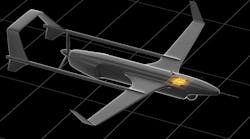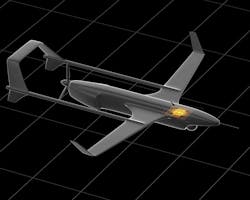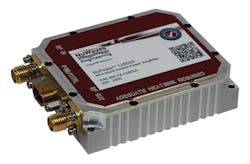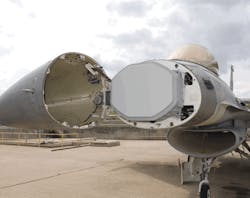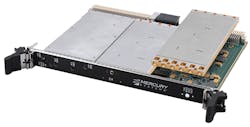This file type includes high-resolution graphics and schematics when applicable.
To support current aerospace and defense systems, technology has moved beyond traditional constructs and iterations to completely new approaches and solutions. The RF/microwave industry faces the task of providing ever-advancing electronic-warfare (EW) solutions while meeting size, weight, and power (SWaP) constraints. A further example of this advanced technology revolves around next-generation radar systems—a number of them are being powered by active electronically scanned arrays (AESAs) based on gallium nitride (GaN), providing capabilities not possible with older systems.
Another critical component within today’s defense sector is the introduction of an open systems architecture for RF/microwave assemblies. Open systems, which bring a standards-based approach to the RF/microwave industry, represent a significant change when compared with traditional approaches to building assemblies. Taking all of this into consideration, it is important to understand the roles these latest developments play in present-day military technology.
An Overall Perspective
At BAE Systems, for example, a focus on RF microelectronics research and development is enabling receivers and transmitters with lower SWaP for military systems (Fig. 1). According to Scott Sweetland, director of advanced microwave products at the company, “Today’s warfighters are facing airspace crowded with signals from commercial and military sources—and enemy threats are evolving. We must be able to identify these threats and respond with effective jamming responses on the fly.”
1. Todayâs EW system designers need to consider the SWaP constraints of smaller-form-factor platforms. (Courtesy of BAE Systems)
Sweetland adds, “Hardware needs to evolve. Custom radio application-specific integrated circuits (ASICs) can’t be easily reconfigured once they’re in the field. The next step is developing new general-purpose solutions that limit obsolescence and can be updated with software, as well as helping get working prototypes into the field faster.”
Technological advances made by BAE Systems can be seen in its AN/ASQ-239 EW suite, which provides advanced EW capabilities to the F-35 Lightning II fighter jet. The AN/ASQ-239 system is equipped with offensive and defensive EW options for the pilot and aircraft. It provides fully integrated radar warning, targeting support, and self-protection to detect and overcome both surface and airborne threats.
EW’s scope is not limited to only fighter jets. “EW isn’t just the domain of advanced fighter aircraft,” Sweetland explains. “Increasingly, there’s a need for man-portable radios and radios for unmanned aerial systems (UASs), which have SWaP constraints. These are all things that RF developers need to keep in mind as they create communications, EW, and signal-intelligence (SIGINT) systems for the future.”
Unmanned Aerial Systems
RF communication systems do play a vital role when it comes to UASs, enabling communication between an aircraft and its operators. As Sweetland also notes, SWaP constraints pose a challenge in this arena.
One company in the RF/microwave space that supports the UAS market is NuWaves Engineering. Recently, the firm introduced the NuPower 11B02A and 12A03A power amplifiers (PAs), which are well-suited for UASs (Fig. 2). Both PAs, leveraging GaN technology, have been designed with SWaP constraints in mind, as the NuPower 11B02A and 12A03A boast form factors of 1.95 and 1.3 in.3, respectively. The company says the NuPower 12A03A’s small size allows for its integration into some of the smallest UASs flying today. In addition, it consumes only 0.85 A of current with a +28-V dc supply voltage, further demonstrating its applicability to SWaP-constrained systems.
AESA Systems Based on GaN
No doubt, GaN technology is having a dramatic impact on the military sector. GaN monolithic microwave integrated circuits (MMICs) are being used to build AESAs, opening up numerous advantages that simply are not possible with systems based on older technology (Fig. 3). “AESAs that are built with GaN MMIC technology are at the core of next-generation radar systems,” says Scott Behan, senior product marketing manager at Qorvo. “AESAs offer a host of advantages over other legacy implementations, including jam resistance, frequency agility, and superior radiating and receiving functionality. They also offer the potential for multi-function operation, including jamming, electronic-countermeasures (ECM), and communications.”
He continues, “GaN MMICs facilitate these functions, offering significant performance enhancement when compared with both historical mechanically scanned radar systems based on vacuum electronic devices (VEDs) and relatively recent solid-state systems using gallium-arsenide (GaAs) MMIC technology. The advantages are numerous, and together help improve the performance, reliability, and availability of AESA systems.”
3. GaN-based AESAs are at the heart of next-generation radar systems. (Courtesy of Qorvo)
Higher-temperature performance is one of the advantages achieved with GaN MMICs. “GaN MMICs enable significantly increased power output at higher temperatures,” adds Behan. “This achievement is due in part to their enhanced thermal-transfer characteristics and their capability to operate at elevated junction temperatures above 200°C.”
AESA systems based on GaN technology can also operate longer than previous-generation systems. “Because GaN MMICs also operate at a significantly lower voltage than historical VED-based systems, they allow use of simpler and more reliable low-voltage system power supplies,” Behan explains. “In addition, GaN MMIC mean time between failures (MTBF) exceeds 10 million hours at junction temperatures above 200°C. These factors enable GaN-based AESA systems to operate reliably for seven-plus years longer than traditional technologies. GaN MMICs do not require periodic maintenance and checkout, and are not subject to degradation due to storage or disuse. They are ready ‘whenever, wherever,’ and can exist indefinitely in an unpowered state and power up instantly when needed.”
Lastly, GaN technology facilitates the ever-present goal to reduce both size and cost. “Perhaps the most important features of GaN-based AESAs are reduced size and weight along with cost-savings,” notes Behan. “Above all, this is what makes GaN technology so central to the ongoing development of advanced radar systems to connect and protect. More compact, cost-effective systems enable platforms to be outfitted with additional equipment, providing the utmost in protection and capabilities for our warfighters. Due to these advantages, GaN continues to be the preferred solution for next-generation radars, enhancing performance in the air, on land, and at sea.”
Open Systems Architecture
GaN is certainly not the only technology innovation making an impact on today’s military electronics. Another is an open systems architecture for RF/microwave technology, which brings a standardized approach to building integrated microwave assemblies (IMAs) (Fig. 4).
“For RF and microwave manufacturers serving the defense sector, the biggest trend by far is the gradual adoption of open architectures from the subsystem to system levels,” says Lorne Graves, chief technologist at Mercury Systems. “This is obviously a major paradigm shift for manufacturers of microwave subsystems—IMAs—for whom every design is different, proprietary, resistant to insertion of new technology, and created to meet the needs of one platform rather than many.
3. A new ingredient in the RF/microwave industryâs technology mix is an open-systems architecture. (Courtesy of Mercury Systems)
“The same approach just won’t work in the future, as adversaries move rapidly to challenge the superiority of U.S. defense technology,” he adds. “Both new and upgraded systems must be able to be deployed in months rather than years.”
The advantages of an open architecture are numerous. Graves continues, “The rationale for open architectures is simple: If employed broadly throughout the Department of Defense (DoD), a modular, well-defined, and scalable architecture would increase transparency and competition by allowing multiple vendors to participate in the initial design as well as upgrades throughout the life of the platform. It would also simplify and speed technology insertion and allow commonality between systems of the same type, such as EW and radar systems. Best of all, from the DoD’s perspective, lifecycle costs would be dramatically reduced.”
While other technologies have taken advantage of open systems, RF/microwave technology has yet to travel the same route. “Open systems have been de rigueur in digital, board-level products for decades,” adds Graves. “The addition of RF and microwave technology, an essential and sometimes the essential ingredient in many types of systems, is the only missing link in making truly open systems possible.”
Although the RF/microwave industry’s approach to building subsystems has remained relatively unchanged, Graves believes that open systems represent the future. He notes, “Open-systems architectures have been debated for many years, but this time the initiative has breadth and depth. It has significant support at all levels of DoD and even in Congress, where several bills have been introduced to mandate open architectures wherever possible. As the microwave industry has been designing subsystems the same way since World War II, it could take many years for open architectures to be fully adopted. But make no mistake: Having so many advantages, especially in today’s fiscally constrained defense budget environment, they are surely here to stay.”
Open systems are still in the very early stages in the RF/microwave arena. However, Mercury Systems has introduced OpenRFM, which supports EW platforms with its creation of a set of open, standardized technologies. Last year, the company introduced the Ensemble RFM-1RS18 tuner—it comes in four configurations, each comprised of as many as three OpenRFM modules.
This report provided insight into some of the technology being utilized in the military arena. Tough SWaP requirements are prompting companies to deliver more compact solutions than ever. GaN technology is clearly a driving force, enabling the next-generation of radar systems. And the introduction of an open-systems architecture—though still in its infancy—has the potential to significantly impact the defense sector. Clearly, the RF/microwave industry is driving a large amount of change that is transforming military electronics. And plans are to continue to meet those critical needs—both today and tomorrow.
